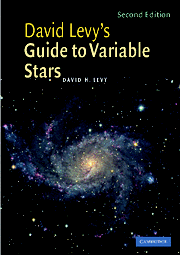Book contents
- Frontmatter
- Contents
- Foreword to the first edition
- Preface
- Acknowledgments
- Part I Getting to know the sky
- Part II Getting to know the variables
- 5 Meeting the family
- 6 Getting started with Cepheids
- 7 Algol, the demon of autumn
- 8 How to estimate a variable
- 9 Names and records
- 10 How your observations help us understand a variable star
- 11 Observing hints
- 12 Observing with CCDs
- 13 Stately and wonderful
- 14 Stars of challenge
- 15 Bright, easy, and interesting
- 16 Betelgeuse: easy and hard
- 17 Not too regular
- 18 Nova? What nova?
- 19 Supernovae
- 20 Clyde Tombaugh's star and the family of cataclysmic variables
- 21 A nova in reverse?
- 22 RU Lupi?
- 23 Orion, the star factory
- 24 Other variable things
- 25 The Sun
- Part III Suggested variables for observation throughout the year
- Part IV A miscellany
- Index
23 - Orion, the star factory
from Part II - Getting to know the variables
Published online by Cambridge University Press: 05 August 2012
- Frontmatter
- Contents
- Foreword to the first edition
- Preface
- Acknowledgments
- Part I Getting to know the sky
- Part II Getting to know the variables
- 5 Meeting the family
- 6 Getting started with Cepheids
- 7 Algol, the demon of autumn
- 8 How to estimate a variable
- 9 Names and records
- 10 How your observations help us understand a variable star
- 11 Observing hints
- 12 Observing with CCDs
- 13 Stately and wonderful
- 14 Stars of challenge
- 15 Bright, easy, and interesting
- 16 Betelgeuse: easy and hard
- 17 Not too regular
- 18 Nova? What nova?
- 19 Supernovae
- 20 Clyde Tombaugh's star and the family of cataclysmic variables
- 21 A nova in reverse?
- 22 RU Lupi?
- 23 Orion, the star factory
- 24 Other variable things
- 25 The Sun
- Part III Suggested variables for observation throughout the year
- Part IV A miscellany
- Index
Summary
Buried deep in the richest part of the winter sky is the magnificent constellation of Orion the Hunter, a group of stars that have a closer relationship than the chance positioning of most constellations. Except for Betelgeuse, most of the bright stars in Orion are roughly the same distance from us. Orion is far more than just a place in the sky, named for a figure from mythology. Orion is a cosmic production plant, whose different divisions show us how stars are made.
The process of star formation is very complicated, but here we can see how it takes place. Young stars in the belt of Orion represent a group of stellar children whose formation is essentially complete. The sword area is a cosmic nursery with some of the stars being less than a million years old. Some astronomers suspect that the area south of the sword, with its hydrogen-rich regions, given another several million years, will coalesce to produce new stars.
In the area where stars are in the process of birth, the highlight is M42, the Great Nebula. The darker your sky, the greater the thrill of such a sight. Here is a nebula whose visual appearance is stunning, whose delicate patterns are exquisite. With a 10 cm (4-inch) telescope, you can make out the beginnings of the complex light and dark gases that share the nebula.
- Type
- Chapter
- Information
- David Levy's Guide to Variable Stars , pp. 135 - 143Publisher: Cambridge University PressPrint publication year: 2005

